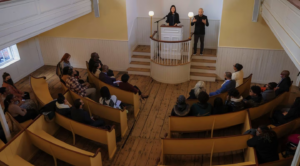The long and public reckoning that followed the Holocaust shows a path forward for a United States that desperately needs to confront its racist past.
In the mid-1950s, a decade after World War II ended, the town of Dachau took down the directional signs that pointed to its concentration camp.
Visitors had swarmed the area — not just survivors of the Holocaust who’d been imprisoned there, but journalists and tourists who wanted to see what remained of the first Nazi concentration camp, where more than 200,000 people were detained and at least 32,000 were killed between 1933 and 1945. The attention exasperated the local population.
A writer for the New York Herald-Tribune made the trip to Dachau in March 1954 and met a German caretaker who tried to convince him that it was the Americans who had built the larger of the camp’s two crematoriums to make the Germans look bad. A clipping from a German newspaper dated around the same time parroted the claim: America had wanted to “pin guilt” on the innocent German people.
Local leaders in Dachau — some of whom would have watched as thousands of people were marched at gunpoint from the town train station to the camp — wanted to be rid of the spectacle. One official recommended that the crematoriums be bulldozed. When the municipal government dismissed the proposal (which had gone public, spurring an uproar from survivors), the town settled for a subtler revision, removing the signs instead.
The excision fit a national mood. Germans weren’t keen to dwell on the atrocities of the Nazi period, let alone to consider what portion of the blame — for the mass murder, the torture, the forced labor — should fall on them. If evidence of the Holocaust couldn’t be razed, at least it needn’t be emphasized. And with the erasure, a counternarrative rushed in to fill the void. In the 1940s and 1950s, Germans were clear about who the war’s real victims were: Who had suffered more than they had?
Decades later, some of the children and grandchildren of the postwar generation would insist that the nation own up to its deep shame. The actions that followed were called Vergangenheitsaufarbeitung, which translates to “working off the past.” The process was so widespread in the 1980s and 1990s that some don’t remember the entrenched, miserable resentment that preceded it.
It fell to private groups to build the first monuments honoring the people who’d been deported to Dachau and killed there. This was in the 1960s — the decade of the famed Eichmann trial, which broadcast the undeniable reality of Nazi crimes into millions of homes around the world, and of the international student protests that would sweep across the United States and Europe. There was a dawning awareness: Something grievous had happened, but too few were willing to admit it.
Even the modest remembrances erected in Dachau and at other sites of mass murder were ambivalent: At Dachau in 1960, a group of Catholic priests funded a small chapel on the campgrounds; its wall texts contained no mention of the Jewish genocide. After further memorials were unveiled there in 1966 and 1967, a British journalist who came to see the camp was disturbed to find the crematoriums concealed behind attractive, well-trimmed hedges. He found that several of the original structures had been demolished, revamped, or enhanced with a fresh coat of paint.
“It means nothing as it is,” a survivor told the journalist. Dachau had been disguised, saidanother critic, “like a witch who wants to appear harmless.”
:no_upscale()/cdn.vox-cdn.com/uploads/chorus_asset/file/21894198/GettyImages_50715656.jpg)
:no_upscale()/cdn.vox-cdn.com/uploads/chorus_asset/file/21894223/GettyImages_1004585172.jpg)
In the runup to and aftermath of German reunification in 1990, Vergangenheitsaufarbeitungcame to be seen as a moral imperative. Germans in their 20s and 30s mined for buried history, in their hometowns and in their families. Those who had fled Nazi terror submitted to in-depth interviews to leave a record of their ordeals; some, frail and aging, even returned to the sites of their torture across Europe. (In 2006, when Steven Spielberg’s archive of the recorded testimonies of tens of thousands of Holocaust survivors became available to Germans via the Freie Universität Berlin, the public broadcaster Deutsche Welle called it “a Holocaust denier’s worst nightmare.”)
Determined to see a more honest reflection of the horrors perpetrated at Dachau, a group of survivors and historians issued a series of recommendations to redo the memorials there. Such acts of cultural rehabilitation and renovation were taking place all across German cities and towns, building on the state-mandated Nazi trials, the disbursal of reparations to victims, the overhaul of organizations like the police and armed forces, and the renewed commitment to and investment in democratic institutions. Dachau — the historical birthplace of the Nazi concentration camp — galvanized to meet the moment.
When I visited Dachau in September 2019, I could see that the work of Vergangenheitsaufarbeitung had taken effect. I walked toward the camp on a trail called the “Path of Remembrance,” which carves the same route across town that victims would have trod from the train station. A reconstructed iron gate at the camp’s entrance reads “Arbeit Macht Frei” — “Work Sets You Free.” I took stock of the watchtower, the guardhouse, the barbed wire that looped like a child’s script around the perimeter. Our German tour guide was unsparing in his account of his nation’s descent into darkness.
But just as the British journalist must have felt when he saw the manicured garden materialize amid Dachau’s bleached landscape, I was unprepared to encounter the lush, pastoral spot where Arthur Kahn was shot and killed in April 1933.
His is a bewildering distinction: Arthur is believed to be the first Jew killed in what would become the Holocaust, dead a mere 10 weeks after Hitler came to power. When he was arrested and transported to Dachau with a group of fellow students, the camp had been open for just two weeks. The deaths of those first Jews were so senseless and violent (Arthur was tortured for hours before his execution) that a local prosecutor indicted the men who’d killed them, a case the Nazis would later suppress.
The place was off to the side of the barracks, unmarked in a grove of tall, handsome trees. The archivists I’d met with when I arrived put an “X” on a map of the camp — a little memorial just for me. I walked over and stood in the place where Arthur had taken his final breaths, the edge of the forest creeping toward me.
“We are honored that you came,” the men in the archive had told me. “And we are very sorry.”




